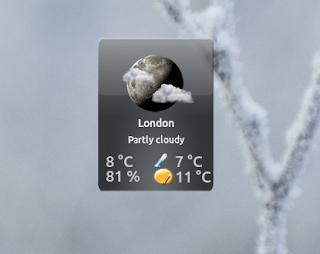
But, if you want a bit more control, this extension can help both Intel and Ryzen-based machines. The ability to toggle between performance modes is now available with recent Linux distributions and newer Linux Kernel releases. This makes things convenient, considering all your important applications get organized right after you sign in your system. It is as simple as adding an application to the list and selecting the desktop you would like that application to open on.įrom then on, every time you open that application, it will open on that particular workspace.
#Gnome shell and my weather indicator windows
Auto-Move Windows allows you to set your applications to automatically open on a workspace/virtual desktop of your choice. If you utilize multiple virtual desktops (or workspaces) like me, this extension will make your workflow much easier. The list is in no particular order of ranking, meaning the extension listed at one is not better than the rest. So, the list of the best GNOME extensions should save you some time. But finding good extensions can be a daunting task. We already have a resource for you to enable and manage GNOME extensions. These extensions add a lot of value to the ecosystem, whether it is to mold the GNOME Desktop Environment (DE) to your workflow, to add more functionality than there is by default, or simply to freshen up the experience.
#Gnome shell and my weather indicator install
There are very few reasons for the average user to actually require knowing the Linux kernel version, but if that's the case, and you do want know it, then all you have to do is install Kernel Indicator.GNOME extensions are a major part of the GNOME experience. The Kernel is the core of any Linux system since it interfaces directly with your computer's hardware. Want to know the Kernel version? Just use Kernel Indicator It just lives in the top bar of your system and displays the Kernel version at all times, unless you either disable or uninstall it. Forget customization options, you can't even interact with the extension as there are no menus or hidden features.

The extension in question is appropriately called Kernel Indicator, and it's whole job is, yep, you've guessed it, to display the kernel version in the top/status bar of your GNOME system, and it works like a charm.Īs expected, it's easy to install, and it offers very little else in terms of functionality. If you're running GNOME, then you're in luck as you don't really need all of the aforementioned procedures, since there's an even easier way of doing that, and it comes in the form of (to no one's surprise) a GNOME Shell extension. Always know what Kernel version your system is using There's also a way of finding out the Linux Kernel using the /proc/version file trick (which revolves around the "cat" command - "cat /proc/version") and some other a bit more complicated ways (using hostnamect, for instance). This is a command that prints/displays various system information including the kernel name and version. One of the most straightforward ways of find out what Kernel version your Linux OS has is with the help of the "uname" command, namely "uname -r". If you're also curious of this, then rest assured that there are a couple of ways to do so, some more easy than others.

How do I check the Linux Kernel version? - a question that most of us had at least once while using Linux.


 0 kommentar(er)
0 kommentar(er)
